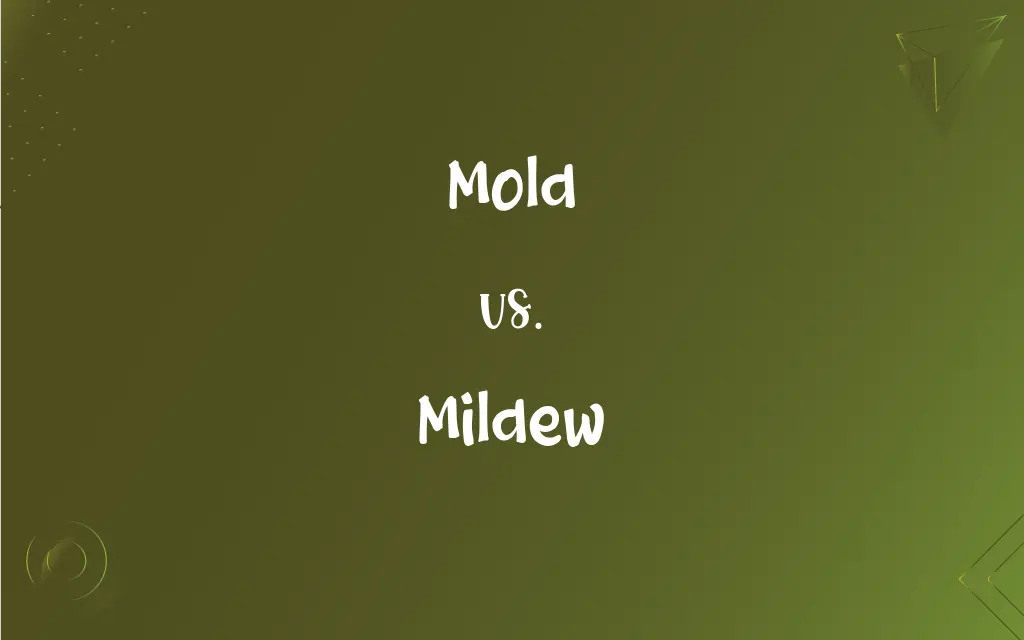Mold vs. Mildew: What's the Difference?
Edited by Aimie Carlson || By Harlon Moss || Updated on July 26, 2024
Mold is a multicellular fungus that can be fuzzy or slimy and comes in various colors, while mildew is a flat, powdery growth, usually white or gray, often seen on plants or damp surfaces.

Key Differences
Mold is a fungus that grows in multicellular filaments called hyphae. These structures give mold a fuzzy or slimy appearance. Mildew, on the other hand, is also a fungus but tends to grow in flat patches, often looking powdery.
Mold can appear in a variety of colors including black, green, yellow, or blue. Its texture can be fuzzy or slimy. Mildew typically presents itself as white or gray and has a powdery or fluffy texture.
Mold is often found on food or inside walls where there is prolonged moisture, especially after flooding. Mildew is frequently seen on plants, paper, leather, and damp surfaces in bathrooms or basements.
Prolonged exposure to mold can lead to respiratory issues and other health problems. Mildew, while also posing health risks, is often less dangerous than mold but can ruin crops and other materials.
To treat mold, one needs to remove the source of moisture and clean the area with specialized solutions. Mildew, being a surface fungus, can often be cleaned easily with common household cleaners, but prevention is essential by reducing moisture and improving ventilation.
ADVERTISEMENT
Comparison Chart
Nature
Multicellular fungus with hyphae
Flat, powdery growth
Color
Can be black, green, yellow, or blue
Typically white or gray
Texture
Fuzzy or slimy
Powdery or fluffy
Common Locations
Often on food or inside damp walls
Frequently on plants or damp surfaces
Health Risk
Can cause respiratory issues if inhaled
Less dangerous but can ruin materials
ADVERTISEMENT
Mold and Mildew Definitions
Mold
The process of shaping something by placing it in a mold.
The artist was skilled in the mold of clay sculptures.
Mildew
A fungus that produces a superficial growth on various kinds of damp or decaying organic matter.
Mildew formed on the old books stored in the basement.
Mold
A hollow container used to give shape to molten or hot liquid material when it cools and hardens.
She used a star-shaped mold for her chocolate desserts.
Mildew
A problem or fault that spreads and has a harmful or unwelcome effect.
The team's losing streak was a mildew on their reputation.
Mold
To shape or influence something or someone.
His experiences in college helped mold his future career choices.
Mildew
To become affected with mildew.
The curtains started to mildew after the flood.
Mold
A fungus that grows in the form of multicellular filaments.
The bread was covered in green mold after being left out for weeks.
Mildew
A discoloration caused by various fungi, especially under damp conditions.
The bathroom ceiling showed signs of mildew due to lack of ventilation.
Mold
A distinctive and typical style, form, or character.
He broke the mold when it came to innovative design.
Mildew
A thin whitish coating consisting of minute fungal hyphae, growing on plants or damp organic material.
The roses were affected by mildew due to the humid weather.
Mold
A hollow form or matrix for shaping a fluid or plastic substance.
Mildew
Any of various fungi or oomycetes that form a superficial, usually whitish growth on plants and various organic materials.
FAQs
Is mold dangerous?
Some molds can release mycotoxins which can be harmful if inhaled or ingested.
How can I prevent mildew in my bathroom?
Improve ventilation, reduce moisture, and clean regularly with anti-fungal agents.
Can mold grow on food?
Yes, mold can grow on perishable items, especially if left in warm, damp conditions.
Why is mildew commonly found on plants?
Mildew thrives in humid conditions and can easily affect plants, especially those with poor air circulation around them.
Is mildew harmful to humans?
While generally less dangerous than mold, prolonged exposure to mildew can cause respiratory or skin issues.
Can mildew damage my possessions?
Yes, mildew can damage materials like paper, leather, and textiles.
How can I identify mold in my home?
Mold can appear as fuzzy or slimy patches in various colors and often has a musty odor.
Is all mold harmful?
Not all molds are harmful, but some can release harmful substances or exacerbate allergies.
How does mildew differ from mold?
Mildew is a flat, powdery fungus growth, usually white or gray, often seen on plants or damp surfaces.
How can I treat mold in my home?
Remove moisture sources, clean affected areas with mold removers, and consider consulting professionals.
What causes mildew on plants?
Poor air circulation, excess moisture, and lack of sunlight can lead to mildew on plants.
Can I paint over mold?
It's crucial to clean and remove mold before painting; otherwise, mold can continue to grow underneath.
Can mold spread easily?
Yes, mold releases spores that can spread to other areas, especially if there's moisture.
What are common household areas susceptible to mold?
Basements, bathrooms, under sinks, and around windows are common mold-prone areas.
Is mildew a type of mold?
Both are fungi, but mildew is a specific kind of mold, typically growing on surfaces in a flat, powdery form.
What is mold?
Mold is a multicellular fungus that grows in filaments and can appear in various colors.
How often should I check for mildew in damp areas?
Regularly, especially after periods of high humidity or rain.
What conditions favor mold growth?
Warmth, moisture, and organic material are ideal conditions for mold growth.
How can I distinguish between mold and dirt?
Mold has a fuzzy or slimy texture and often emits a musty smell, while dirt does not.
Does mildew have a distinct smell?
Yes, mildew often gives off a musty, damp odor.
About Author
Written by
Harlon MossHarlon is a seasoned quality moderator and accomplished content writer for Difference Wiki. An alumnus of the prestigious University of California, he earned his degree in Computer Science. Leveraging his academic background, Harlon brings a meticulous and informed perspective to his work, ensuring content accuracy and excellence.
Edited by
Aimie CarlsonAimie Carlson, holding a master's degree in English literature, is a fervent English language enthusiast. She lends her writing talents to Difference Wiki, a prominent website that specializes in comparisons, offering readers insightful analyses that both captivate and inform.































































